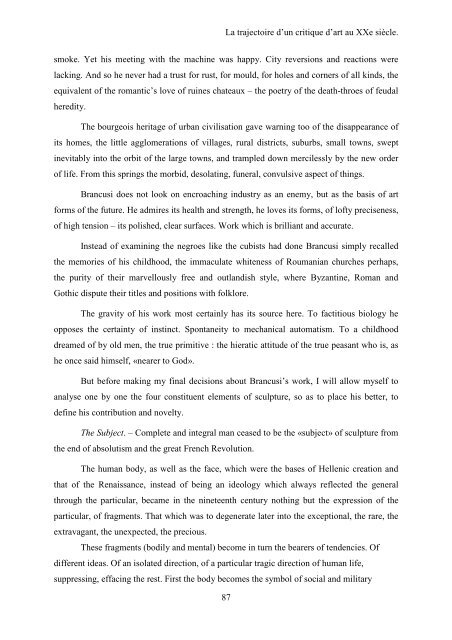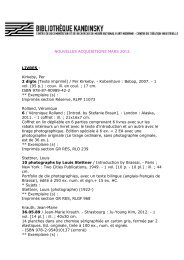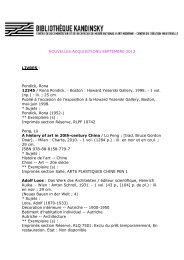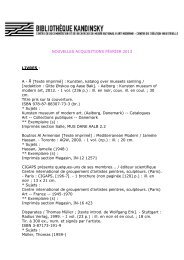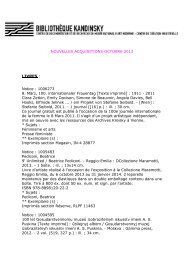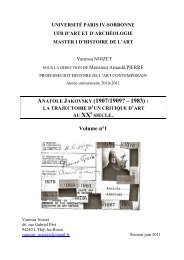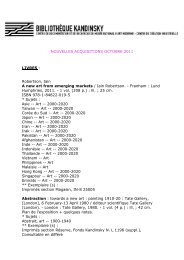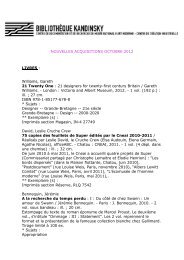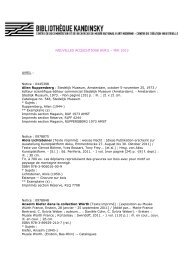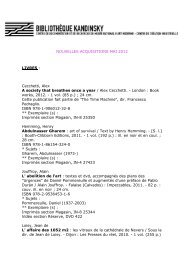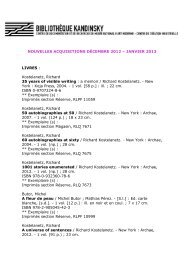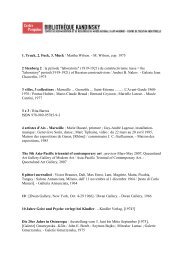anatole jakovsky (1907/1909 ? â 1983) - Bibliothèque Kandinsky
anatole jakovsky (1907/1909 ? â 1983) - Bibliothèque Kandinsky
anatole jakovsky (1907/1909 ? â 1983) - Bibliothèque Kandinsky
You also want an ePaper? Increase the reach of your titles
YUMPU automatically turns print PDFs into web optimized ePapers that Google loves.
La trajectoire d’un critique d’art au XXe siècle.<br />
smoke. Yet his meeting with the machine was happy. City reversions and reactions were<br />
lacking. And so he never had a trust for rust, for mould, for holes and corners of all kinds, the<br />
equivalent of the romantic’s love of ruines chateaux – the poetry of the death-throes of feudal<br />
heredity.<br />
The bourgeois heritage of urban civilisation gave warning too of the disappearance of<br />
its homes, the little agglomerations of villages, rural districts, suburbs, small towns, swept<br />
inevitably into the orbit of the large towns, and trampled down mercilessly by the new order<br />
of life. From this springs the morbid, desolating, funeral, convulsive aspect of things.<br />
Brancusi does not look on encroaching industry as an enemy, but as the basis of art<br />
forms of the future. He admires its health and strength, he loves its forms, of lofty preciseness,<br />
of high tension – its polished, clear surfaces. Work which is brilliant and accurate.<br />
Instead of examining the negroes like the cubists had done Brancusi simply recalled<br />
the memories of his childhood, the immaculate whiteness of Roumanian churches perhaps,<br />
the purity of their marvellously free and outlandish style, where Byzantine, Roman and<br />
Gothic dispute their titles and positions with folklore.<br />
The gravity of his work most certainly has its source here. To factitious biology he<br />
opposes the certainty of instinct. Spontaneity to mechanical automatism. To a childhood<br />
dreamed of by old men, the true primitive : the hieratic attitude of the true peasant who is, as<br />
he once said himself, «nearer to God».<br />
But before making my final decisions about Brancusi’s work, I will allow myself to<br />
analyse one by one the four constituent elements of sculpture, so as to place his better, to<br />
define his contribution and novelty.<br />
The Subject. – Complete and integral man ceased to be the «subject» of sculpture from<br />
the end of absolutism and the great French Revolution.<br />
The human body, as well as the face, which were the bases of Hellenic creation and<br />
that of the Renaissance, instead of being an ideology which always reflected the general<br />
through the particular, became in the nineteenth century nothing but the expression of the<br />
particular, of fragments. That which was to degenerate later into the exceptional, the rare, the<br />
extravagant, the unexpected, the precious.<br />
These fragments (bodily and mental) become in turn the bearers of tendencies. Of<br />
different ideas. Of an isolated direction, of a particular tragic direction of human life,<br />
suppressing, effacing the rest. First the body becomes the symbol of social and military<br />
87


